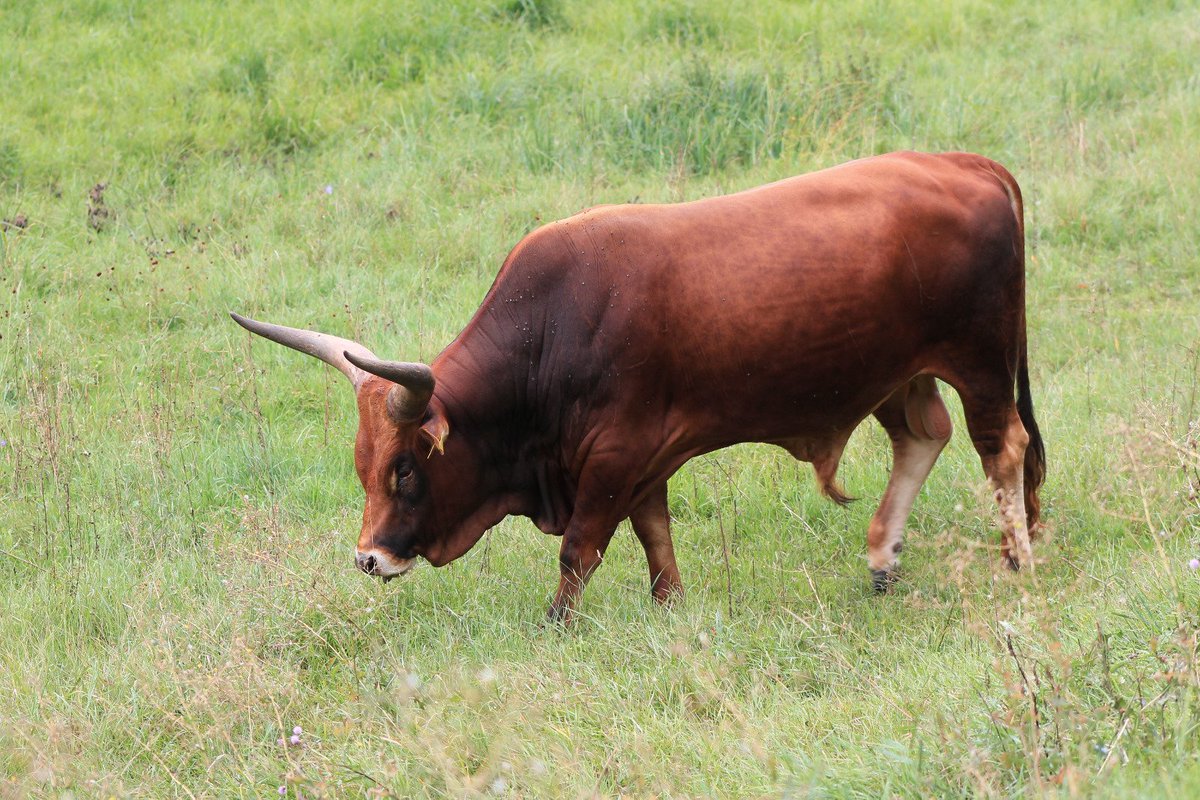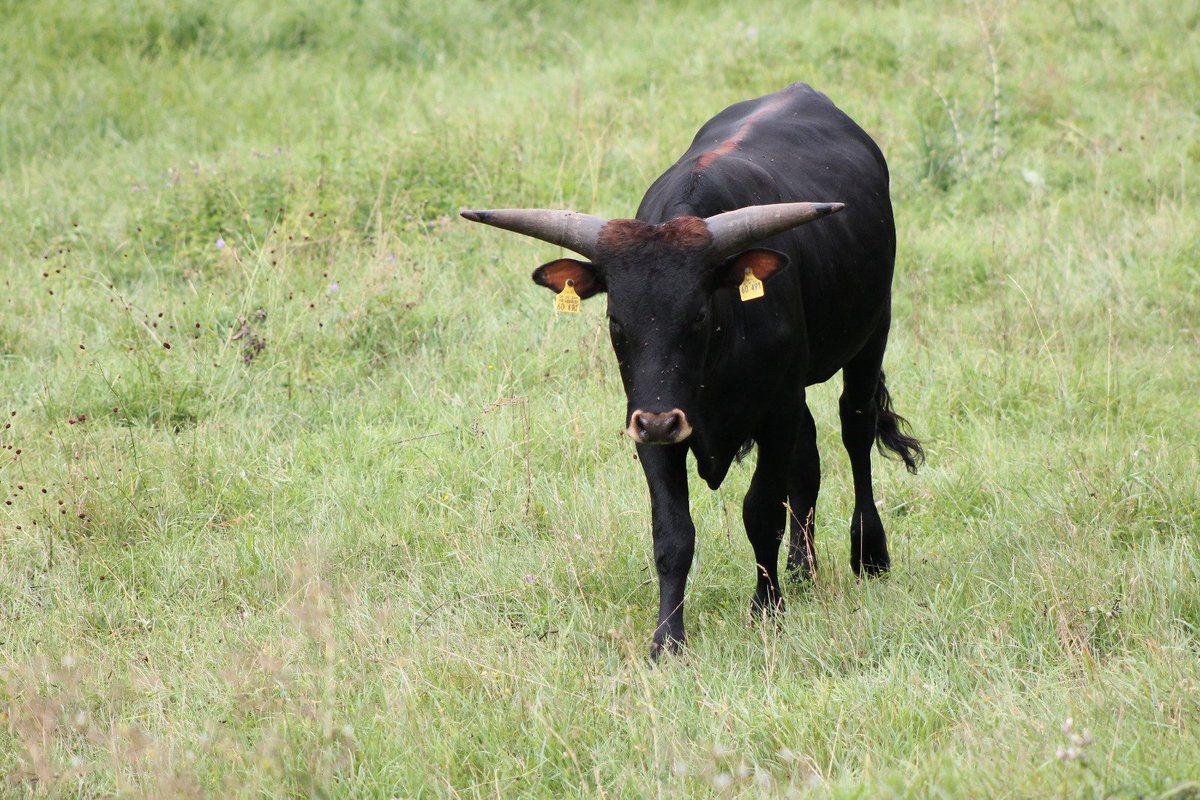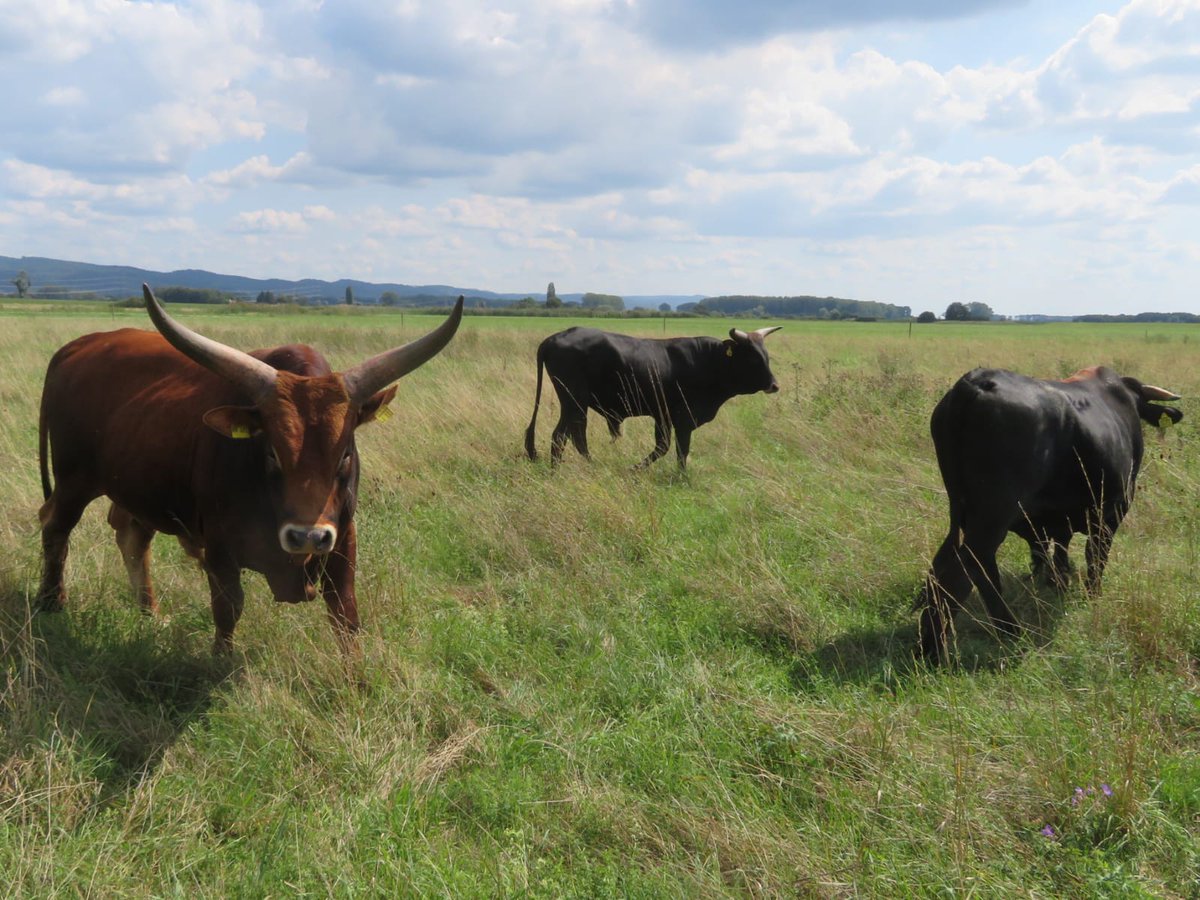Last summer, I did some posts on domestication in general, the exact organismic differences between wild and domestic, between cattle and aurochs, and how this might impact the topic of “breeding-back”. The posts are the following:
It is really a lot of content but truly relevant for the understanding of this topic and a lot of my posts, which is why I thought it would be nice to provide a little handy overview by summarizing the posts in one.
The real differences between aurochs and cattle
All aspects of a living organism are interconnected via pleiotropic effects (when genes influence more than one trait) and developmental cascades. Hormonal activity, which is regulated by development, influences behaviour as much as morphology. Colour genes also play a role in metabolism and neurology. Not only there was massive directive selection executed upon the animals by humans, also many of the natural and sexual selective factors were eliminated by human custody. So it happens that domestication dramatically altered the whole organism in nearly every aspect: genomic, developmental, neurological, morphological, behavioural and ecological.
Domestication affected all domesticated mammals in a very similar manner, a phenomenon which is called the domestication syndrome. Cattle are a perfect example of the domestication syndrome. The “symptoms” include reduced fight/flight reaction, increased agreeableness and docility, lethargic behaviour, reduced sexual dimorphism, paedomorphy (retention of juvenile characters, f.e. in skull shape), reduced body size, reduced limb size, reduced brain volume, elongated appendages such as skin flaps, hanging ears (in zebuine cattle), many deviant colour variants, changes in horn shape and size or loss of horns, loss of seasonal adaptions in the reproduction circle.
The effects on developmental biology in cattle might be responsible for many of the morphological changeswe see. In particular, it was a developmental delay that causes ontogeny to stop earlier, leading to paedomorphy and probably also affecting horn size and shape (see the Latino example) as well as body size. Endocrinology (hormonal activity) might be the key for the classic domestic cattle phenotype. Especially the thyroid and corticosteroid activity might result in the reduced muscling, enlarged belly, hanging spine, shorter body size and reduced limb length and brain volume we see in domestic cattle. Since neurological genes also affect colour cells, selection on behavioural traits might have also caused the classic domestic piebald pattern. Artificial selection and a lack of natural and sexual selection probably also led to a considerable loss of physiological fitness. If the physiological differences between cattle and aurochs are comparable to what happened in yaks, domestication must have affected endurance, respiration, digestion and other factors, increasing the death rate in winter. As in horses, it might have also affected skeletal articulation, locomotion and the cardiac system. Domestication also causes a loss of genetic fitness, called the costs of domestication. Lacking selection, inbreeding and mutation accumulation leads to an increase of deleterious alleles, affecting various organismic factors. In the post From aurochs to cattle: step by step you can see a stepwise illustration of the changes from aurochs to cattle.
Summing up all those differences made me conclude:
these dramatic differences [...] make “the aurochs was larger, had a specific colour and different horns” rapidly loose meaning and almost sound like Kindergarden stuff to me. And judging on a total organismic level it actually is.
This, in turn, means that just a similarity in horns and colour are not even a tiny bit of the whole story.
Considering the complex interplay of all the factors concerning morphology, behaviour, endocrinology, development and the genetic base underneath it is very unlikely that traditional breeding can simply reverse domestication. This is why some modern projects now claim to execute “breeding-back” on a genetic level. A claim that will be covered in the next section.
Is “genetic breeding-back” possible
The basic argument of “genetic breeding-back” is that no original wildtype alleles (“genes”) would have been lost during domestication but simply been split up among modern domestic cattle, and that “genetic breeding-back” aims to trace down those alleles and unite them back in one population.
This scenario, communicated in press releases, faces two problems: 1) Are truly all aurochs alleles still present in the modern cattle population? 2) have those alleles been traced down in modern cattle?
In order to answer the first question we have to focus exclusively on the defining key aurochs genes. Not haplotypes or other phylogenetic markers, but those genes that regulate the defining differences between aurochs and cattle described above. Considering the complexity of most of those factors, I concluded: “So my personal estimate that the number of genes regulating all the developmental, endocrinologic, neurologic, and morphologic differences between domestic and wildtype, cattle and aurochs, might be hundreds, or even thousands of loci“
Most important to note is that it has not been identified what those particular genes involved are. Not in the aurochs, and not in any mammal.
The evolutionary process cattle underwent at the beginning of their domestication makes it very unlikely that all of the wildtype alleles survived this process. A very small population of aurochs was snatched out and put under massive directive selective pressure. Nowadays not all cattle are domesticated to the same extent, some are more some are less derived, but some basic organismic changes (see above) are universal to all of them, and so must be the genetic changes causing them, which makes it very likely that some of the wildtype alleles on the loci controlling these changes must have been lost completely in all strains of cattle, otherwise those changes would not be universal. The population genetic process cattle underwent during the last 8000 years – a very small population that was put under massive directive selective pressure and millennia of more or less strict reproductive isolation – leave little room for a survival of all wildtype alleles.
Even if all the original genetic material of the aurochs was still present and split up among modern domestic cattle, the particular loci of the key genes must have been identified (which is not the case yet) and the specific alleles, wildtype and domestic, must have been identified and traced down in modern cattle (which is not the case either). Thus it is not known which breeds carry which aurochs alleles and to which extent because the necessary scientific framework has not been done yet. Consequently, as the necessary information is not there yet, no current “breeding-back” project is able to carry out breeding on a “genetic level”. Studies on phylogenetic markers and SNPs are nice but do not investigate the key genes responsible for the differences between domestic cattle and their wildtype. Therefore, “genetic breeding-back” exists only in press releases.
Cattle are “designer aurochs”
“Cattle and aurochs” is actually a wrong dichotomy. There is no distinctive, definite line between those two animal types as the transition from a wild bull to a Fleckvieh bull was fluent and aurochs and cattle probably hybridized without any obstacles on occasion wherever they neighboured. Actually, cattle are man-made modified designer aurochs – “cattle” is just the term we use to refer them to. Therefore, it is helpful to describe cattle simply as modified aurochs instead of creating a separate category of animal, and for my post Cattle are designer aurochs I chose individuals of three breeds: Maronesa, a less-derived one; Fleckvieh, a derived one; and Heck cattle, a mosaic of derived and less-derived breeds. It shows that the Maronesa and the Heck bull are less derived in aspects like colour and horns, but that the morphological changes (reduced body, limb and head size, elongated trunk, reduced muscling, enlarged intestinum, reduced brain volume, changes in horn curvature and volume, enlarged appendages) as well as behavioural (trainability, reduced stress response, docility and lethargy compared to the wildtype) and probably the developmental changes causing them (changes in corticosteroid and thyroid metabolism, developmental delay and other factors) are universal to all three cattle exanimated, and possible all taurine cattle on this world as this is a look at both derived and less-derived cattle. There is the physiologic and genomic level as well, which cannot be tested based on photos.
The looks vs behaviour problem and the Spanish fighting bull
When looking at the breed Lidia, the Spanish fighting bull, however, it shows that Lidia is the least-derived breed in this respect. Lidia do have reduced body size, limb size and brain volume, but they are the one cattle breed in the world with the most wild cattle-like body shape. Especially young individuals have a muscular body with a slender waist, and they are the cattle breed with the largest hump. In essence, they look like more like hypothyreoditic aurochs rather than normal domestic cattle, which might indicate that the effects on hormone activity are not as intensive in Lidia as in other domestic cattle. However, whereas most domestic cattle have a drastically reduced fight/flight reaction, that of Lidia is very intense. The argument that the behaviour of Lidia is “unnatural” is baseless as we have no living aurochs to compare with and the very tame and docile nature of most other cattle breeds is not the wildtype state either. It might be that the aggression level of Lidia is intensified compared to aurochs but their aware behaviour is certainly more wildtype-like than lethargic docility.
Considering that behaviour and morphology are interconnected via pleiotropy and developmental cascades, it would be an interesting question if it is no coincidence that the least-tame breed in the world is also the one with the most aurochs-like morphology. The farm fox experiment shows that most of the symptoms of the domestication syndrome go hand in hand with a selection on tame behaviour. This provokes the question whether a long-legged, athletic, long-snouted bull or cow that is shaped and coloured like an aurochs but still is more or less tameable and relaxed and not explosive in behaviour is a contradiction in itself. Maybe it is indeed impossible to remove all morphological vestiges of domestication (especially regarding body morphology and skull shape) by selective breeding on optical traits alone. In foxes, for example, conscious breeding for earlier maturity and larger litter size was unsuccessful, while selection on tameness resulted in exactly that.
An interesting question that rises is whether Lidia always have looked and behaved like that since the domestication of cattle or if their ancestors were ordinary primitive cattle like other Iberian breeds that acquired this wild cattle-like morphology in the course of selection for aggression.
Even more interesting would be the reverse test of the farm fox experiment with cattle: taking already aurochs-like cattle and selecting them on wildtype behaviour (more intense fight/flight reaction, shyness, explosiveness and other aspects) in order to see if they indeed re-evolve a wild type-like morphology. Such a project would require a different way of keeping them compared to grazing projects, but it would definitely be worth a try.
A test for breeding-back: the Tamaskan dog
Since we cannot directly compare “breeding-back” cattle with the aurochs as it is extinct, it would be an interesting test for “breeding-back” to do the same with a domestic species whose wildtype is still extant in order to see if it is an efficient way to achieve the goal at all. This has basically been done with wolves and dogs in the form of the Tamaskan breed. The breed was bred using sled dogs, malamutes, huskies and German shepherd dogs in order to create a wolf-like appearance without any crossing-in of wolf dogs or wolves. The overall appearance of a Tamaskan is very similar to a Holarctic grey wolf, the matches in body size, proportions and body shape as well as colour are very wide-ranging. However, a closer look shows that it is clearly a dog. Especially head is larger and paedomorphic (snout, teeth size, eye size). The Tamaskan also has all other symptoms of the domestication syndrome: loss of acuteness of senses, earlier maturity and loss of seasonal reproduction, tame and trainable behaviour with greatly reduced fight/flight reaction. Wolfdogs, on the other hand, which are hybrid breeds of German shepherds and wolves, have a recognizable different behaviour. Tamaskan dogs display a usual domestic dog behaviour. Czechoslovakian and Saarloos wolfdogs are more independent than usual dogs, shy to strangers, easier to scare, need early socialization, have a strong hunting instinct, are more enduring and remarkably good at tracing. So there are morphologic, physiologic and behavioural domestic traits that breeding exclusively domestic individuals for a wildtype-like appearance could not eradicate. This leads to the question what “breeding-back” can achieve at all.
What breeding-back can achieve
Since wild and domestic animals differ dramatically on many levels (morphology, genetics, physiology, behaviour, development, endocrinology), and some basic key alleles of the aurochs probably went lost during domestication and thus “genetic breeding-back” is probably not feasible and the scientific framework is not done for it yet, and since classic breeding with domestic animals alone cannot produce a true reconstruction of the wildtype that lacks universal domestic traits, what can “breeding-back” achieve anyway?
Looking at one of the best breeding-back results that have been achieved so far, the Taurus bull Lamarck, reveals the borders of breeding-back: It matches the aurochs in size and colour, the horns are good, the skull is OK, the proportions and body shape are good. However, it still has all the symptoms of the domestication syndromes: The muscling is still reduced and the intestines are enlarged, the skull is paedomorphic compared to a wild aurochs, the hump is reduced, as is the sexual dimorphism and seasonality of the reproduction circle in the population. Also its behaviour is comparably tame and relaxed. Therefore Lamarck is, albeit being rather aurochs-like in appearance, domestic cattle. The horn shape, body shape and skull shape could be improved by breeding, but the animals would remain domestic.
The symptoms of the domestication syndrome have a millennia long history in the genetic architecture of the animals and cannot simply be reversed by selective breeding with these domestic animals alone. All in all, the maximum that can be achieved is a “bovine Tamaskan”. This might sound disillusioning, but a bovine Tamaskan would be more aurochs-like than it sounds at first and absolutely sufficient for the basic goal that is filling the niche of the aurochs with something very alike. Aurochs and cattle probably fulfilled the same ecologic niche (aurochs were probably better at digesting food and seizing the nutrients, but the food choice probably stayed the same). The social behaviour of aurochs and cattle probably is the same, as what we know of the aurochs is congruent with that of cattle and cattle have the same behaviour as living wild bovines, so the aurochs must have been the same in this respect. Cattle did loose a lot of fitness during their domestic evolution, but there are numerous examples of self-sustaining feral cattle populations that descended from rather derived breeds, so establishing wild populations of these bovine Tamaskans should be no problem as well.
Thus, breeding-back results will always remain domestic, but they would be very much like the aurochs in many respect and would fill the niche of the aurochs successfully and authentically. And after many generations of dedomestication in the wild, they would become a new, post-domestic wildtype that resembles the pre-domestic wildtype to a large extent.
And if we can genetically reconstruct an aurochs by cloning or CRISPR-Cas9, even better. What to do with a genetically reconstructed aurochs is covered here.









